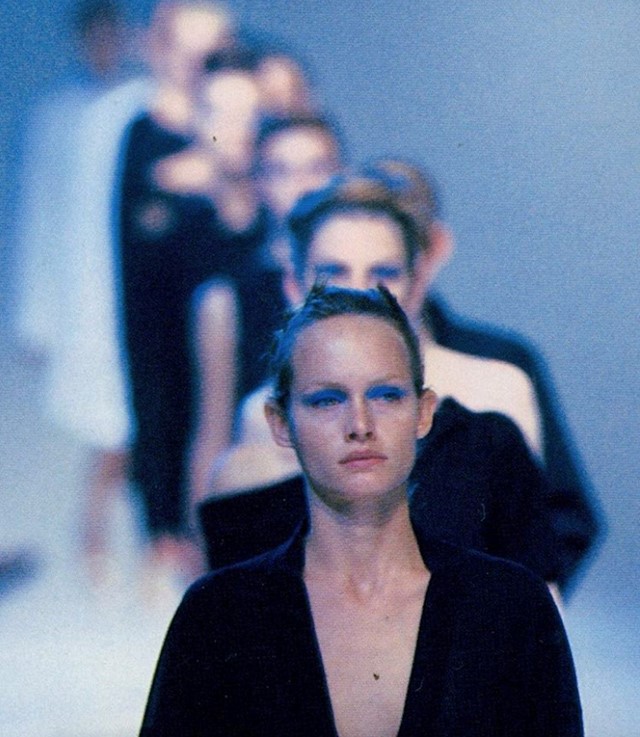@archivings.stacks provides a visual catalogue of rarely seen fashion imagery
Already something of a go-to for the fashion compulsive – it counts stylist Benjamin Bruno, Patric DiCaprio of Vaquera and photographer Benjamin Huseby as some of it’s almost 8,000 followers – @archivings.stacks is a trove of predominantly pre-2000 fashion imagery, previously existing only in the pages of out-of-print magazines (or found in the outer reaches of Japanese auction websites).
As such, the account – begun almost five years ago by Montreal-based Shahan – relishes in the obscure. A recent survey of posts includes an invitation to Issey Miyake’s Spring 1991 show, designed by Tadanori Yokoo, four scans of models’ hands holding eggs at Laboratoire Spring 1997 and a pair of Spring 2001 Helmut Lang leather briefs, found on eBay. Much of this material belongs to Shahan himself – calling himself a “scavenger” and “librarian” at once, images are predominantly scanned from the – generally runway – magazines which existed in a time before Vogue Runway (or even its predecessor, Style.com).
The preoccupation with collecting began when Shahan moved from the small town in Canada where he was born to Toronto, discovering among the city’s second-hand bookshops stacks of out-of-print, or decades-old, fashion publications. “Some of them were runway magazines,” he explains. “One of the first ones I found was from a season in Tokyo; it was like Fall 1999. I was just looking through it and I was just blown away because I hadn’t seen any of these images and I hadn’t heard of any of these designers.”
Discovery is essential to @archivings.stacks. “I was finding images that I hadn’t seen anywhere else, and if I tried to search for them online I couldn’t find them,” he explains. “I knew I could bring something to the table, I guess.” It came with a growing necessity to share what he was finding – at the time, on Tumblr, where he was posting – and Shahan remains generous with the images he finds. “I’m happy that people are reposting things, the point is to make it available; I’m happy that people are finding something that they like and sharing it with others.”
Much of the account’s appeal comes from the way it circles in on details which might be missed on first glance. “I end up being like, ‘oh there’s kind of an interesting image within this image’,” he says. “Maybe it’s of like a person observing this show or an arrangement of the piece at the show.” A series of posts focussing solely on a (pre-iPhone) front row, for example – recently, he picked out a young Raf Simons at Dirk van Saene’s Spring 1998 show for PZ Opassuksatit’s PZWorld book, published by IDEA – another simply on model’s mid-sections. As such, far from a typical Instagram moodboard, Shahan’s touch can be felt throughout.
His chief fascination – though there are many – is the work of Japanese fashion designers. Junya Watanabe, Issey Miyake and Comme des Garçons feature frequently, alongside more obscure names like Mixed-Up Confusion, Gomme and Shinichiro Arakawa. “I like Japanese fashion because it’s about colour and standing out and trying,” he explains. “In western culture it’s a bit more frowned upon to try as hard, or to be cute and happy. I was drawn to that combination of fun and irreverence.” A favourite magazine of his is the now-defunct High Fashion – once a kind of Japanese Vogue, he thinks – of which the few editorial photographs he posts are from. There is one particular copy he remains in desperate want of – the cover depicting the character from a Playstation horror game “wearing” Yohji Yamamoto on the cover. He has no idea what’s on the inside. He often doesn’t.
For now, it means he has little interest in contemporary fashion. “I see that I don’t really see any need for my input, I guess,” he says. “I’ve kind of realised I have a very specific interest when it comes to that world, and it’s more about clothing and like sort of an isolation of a garment, rather than the pomp and circumstance that comes with runway shows now.” Instead, he sees himself as a “scavenger” – a skill he now takes into his offline life, undertaking various research projects for clients across disciplines (most recently, a sculptor).
It is growing up on the internet, though, which he credits as the reason he continues to post as @archivings.stacks. “Maybe this is just from being online for so long, but I don’t think I can enjoy something as much alone as I can with other people,” he says. “I like to obverve people enjoying it, and reading a reaction to it... or just to see it be well liked.”
